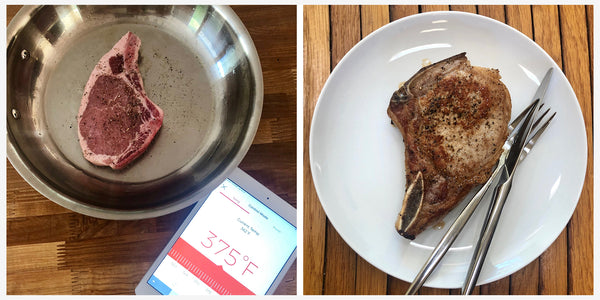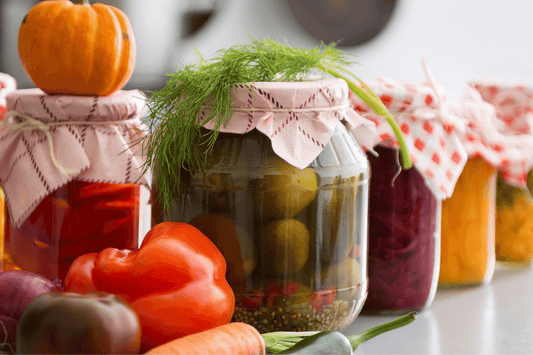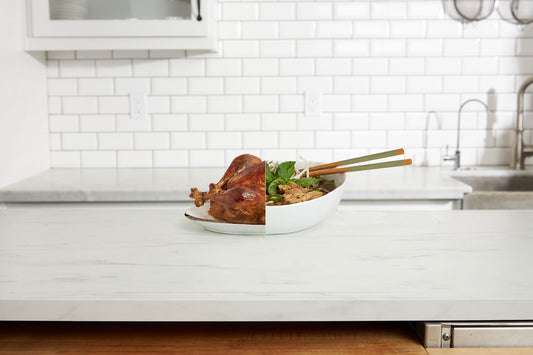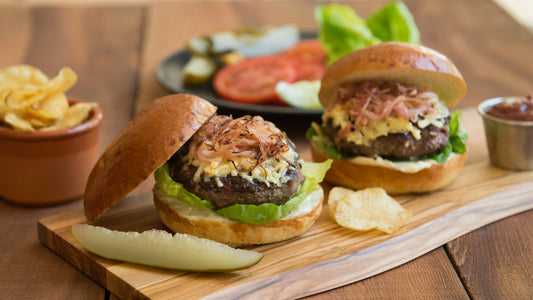By Julian Weisner, Culinary Scientist
Guide to Pan-Seared PorkThe Secret to Foolproof Pork Chops
A pork chop has become a bit of a catch-all term for a few different cuts you will see at your local market or butcher. At the end of the day all of these cuts come from the pork loin. From front to back there are 3 different cuts to focus on:
- Rib Chop. This is a section of the pork loin with a flavorful bone, reminiscent of a ribeye steak, often served in restaurants.
- Loin Chop. If the bone is removed, or if we were to proceed further along the pig, you’ll end up with a loin chop. This is a rounded boneless cut, which usually has a ¼” layer of fat on one side.
- Pork Porterhouse or Center-Cut Chop. Even further along, towards the back end of the pig, when both the loin and tenderloin are in your chop it will look like a small Porterhouse or T-bone steak. This is a delicious cut which contains the even leaner pork tenderloin as an added bonus. This is usually called a pork porterhouse or a center-cut chop.
Cooking Pork Chops in a Pan

Cooking pork chops in a pan is quite possibly the best way to prepare them. Unlike grilling or roasting, a pan allows you to get the most amount of color on your meat while you cook it to juicy perfection. Not only does it produce more color, and therefore more flavor, but it is fast and easy.
The times and temperatures in the chart provided are built for the pork loin chop. This guide will help you cook all of these cuts nicely, however; be careful with the pork porterhouse as the tenderloin is significantly leaner than the loin, and will cook much faster.
Temperature and Timing Chart for Pan Searing Pork
If you want to up your game you can use the chart below as a jumping off point and adjust the temperatures to perfect your favorite pork chop.
Download the Printable Time and Temp Chart for Pork
The Effect of Temperature on Pan-Seared Pork
Temperature has a much larger effect on color than it does on doneness. Say you're looking to achieve a pork chop cooked to "medium" doneness. If you decrease the temperature of the pan from 375ºF to 325ºF, and increase the cooking time to achieve that same "medium" result, you'll end up with a much lighter exterior coloring. Why does this matter? Well, color is flavor. Think of toast. Uncooked white bread, lightly toasted bread, and burnt bread are all bread, but a different color, and therefore a different flavor. It is the same with meat. We want our pork like our bread- toasted but not burnt. So, the best way to do this is to manipulate the cooking temperature to zero in on our favorite flavor of toast (or in this case, pork).
Cooking Times for Pan-Seared Pork
Usually cooking involves a lot of checking and double checking. A lot of people try to practice the poke method, they poke their meat and try to decide if it is firm enough to be done, although there is technical merit to this, it takes a lot of skill and practice. Others, cut into their meat when they think it is close, but this is isn’t great either because it does not account for resting, and is very likely to dry your meat out. A few people out there even use instant read thermometers, this is one of my favorite methods because it can give you accurate real time information on what is going on with your food. Even with a thermometer, you still need to take into account resting time and cooking technique. With the use of precise temperature control, there is no need for thermometers, or any poking and prodding.
You can see that timing plays a big factor in doneness in all of our temp guides. In pork we can see a nice side by side comparison on how the thickness of your chop affects the timing for each doneness. For example the 0.5” pork chop takes 1min 50s to get to medium and 2 min and 30 seconds to get to Medium Well, that’s a difference of 40 seconds. Not bad, but an easy miss. When we cook thicker meat, the time between each doneness increases. A 1” chop, for example, takes 5min 15 seconds to reach M, and 7 min for MW, that’s a 1min 45 second difference. A whole minute of time is added between each doneness by increasing the thickness of our chop only ½”.
Full Step-by-Step Recipe for Pan-Seared Pork:
How to Cook Pork Chops in a Pan, Step by Step
Precise Temperature Conversions for Stovetop Cooking
We accounted for those ambiguous low / medium / high settings that you see on most stovetops and built a reference chart. It is not perfectly 1:1, but it is a great reference. To skip the vague and inaccurate stovetop cooking settings and get down-to-the-degree control, you can give the Hestan Cue System a try for 101 days. If you don't love it, we'll pay for the return shipping and give you your full money back. While you mull that over, here's your conversion chart for your stovetop.

FAQs for Pan-Cooked Pork
Q: I cooked my Pork Chops sous vide. Can I use the same times and temperatures to sear it when I finish it?
A: No, after sous vide cooking you don't need to cook your pork any more than it is. These times and temperatures will only ruin all of your hard work. Check out more from the Cue chefs in our Quick Guide to Searing Sous Vide Proteins
Q: When should I season my pork?
A: As long as you season the chops before they goes in the pan, and make sure it is dry when it gets there, you'll be fine...
Q: Can I use this guide to cook chops with the bone in, or out?
A: Yes! For both cuts, simply follow the guides, but for bone-in cuts, we recommend basting your pork chops on the last cook step. Focus your basting on the bone side of the meat as well as the thicker sections to achieve a consistent cook through out. This is because the bone shields the meat from the pan, so it takes a bit longer to cook.
Q: Do I need to baste the pork chop?
A: No, it is not necessary, but in general, basting can seriously help cook all of your meat more evenly, and we highly recommend doing so. Plus, basting with aromatics in the pan is a restaurant style technique that adds flavor and is sure to impress your friends and family.
Q: Can I add aromatics, like thyme, rosemary, or garlic to the pan?
A: Absolutely, aromatics are a great way to add flavor. We recommend adding aromatics during the last cooking step, baste the aromatic infused oil on top of your steak during this last step to impart as much of the flavor as possible.
Q: Can I cook my pork chop straight from the freezer?
A: No, these times and temperatures are designed for pork either out of the refrigerator or even after it has been tempered.
Q: Can I reheat cooked pork with these times and temperatures?
A: No, since your meat is already cooked it will not need to spend nearly as much time to come back up to a servable temperature. Do yourself a favor and whip up something fun like pork fried rice, a chop and eggs breakfast, or a porkchop and apple hash!
Q: Does my pork chop need to rest after it's done cooking?
A: Yes, the cue system factors in "rest time". This means that we calculate how much your pork chop will continue to cook out of the pan, and account for that. Consider the rest time an additional cook time, and wait at least 5 minutes before eating.
Q: Does it matter if I temper my pork chop before I cook it?
A: Yes, these numbers are built for an average starting temperature of about 45ºF/7ºC (for reference your fridge is probably 37ºF/3ºC, if you want to cook your pork directly out of the fridge, you should add a little bit more cook time, likewise if you have taken the time to temper, you can decrease the cook time to get an even juicer result.
Q: What if my chops are different thicknesses?
A: You can cook them all at the same time, just set separate timers for each.
Check out the Hestan Cue app for iOS and Android to learn more about precision cooking with Cue, and all the things you can do! If you found this guide helpful, please let us know–we would love to hear your feedback.
Keep us posted with photos of your experiments and share your results and #CueTips with the community!





